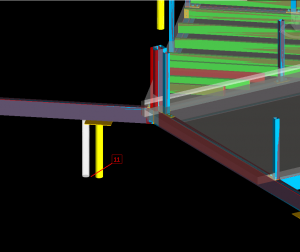The second article in our Guest Blogger Series comes from Jennifer MacDonald.
Jennifer is a lecturer in Construction Management at the University of Technology, Sydney, and is currently completing a PhD in BIM and collaborative design education at the University of South Australia. She was involved in the survey and analysis work behind the BIM Economic Study and the National BIM Initiative, provided advice on the National Industry Education and Training (NIET) plan and served on the AIA BIM Education Working Group.
With partners at UniSA and Newcastle Uni, she recently completed work on an OLT-funded project to develop collaborative AEC curricula with the aid of BIM tools and processes. The results of this can be found on the codebim.com website, which Jennifer aims to develop further into a resource for all AEC academics. She hopes to improve the way the construction industry functions, one student at a time!
ôTogether we’ll stand
Divided we’ll fall
Come on now people
Let’s get on the ball
And work together
Come on, come on
Let’s work togetheràö
A striking feature of most of the government/client mandates for BIM around the world has been the requirement for Collaborative BIM. In the UK, the requirement is for ôfully collaborative 3D BIM (with all project and asset information, documentation and data being electronic) as a minimum by 2016ö (equivalent to Maturity Level 2 on the ubiquitous ôBew-Richards diagramö). The National BIM Initiative in Australia (yet to get Federal approval but we can hope!) recommends a similar mandate to the UK’s. The US, preferring to use alternative jargon, has stated that ôimproved job-site efficiencyö will be achieved by ômore effective interfacing of people, processes, materials, equipment, and information.
The UK mandate, in particular, has had an energising effect on the uptake of BIM. However, being able to realise the promised efficiency savings relies more on people and process change than any technologies, and the industry is waking up to the fact it has some major cultural problems hindering progress, and that many of these problems originate in the education of our construction professionals.
Construction is a litigious, inefficient industry, with low levels of trust and poor information sharing. More money is used by many firms to resolve disputes than they invest in R&D. The temporary nature of construction teams, comprising members from many different organisations, with clear (and fiercely protected) demarcation lines between occupational roles, has contributed to the negative culture. This lack of trust does not encourage information sharing and collaboration. The construction industry has expressed a need for graduates skilled in collaborative building design and BIM, but, unfortunately, the silo-d culture extends down in to the segregated teaching of students of the architecture, engineering, and construction (AEC) disciplines.
I should probably enter a disclaimer here: I worked as a structural engineer for nearly ten years in industry in both the UK and Australia, before turning my hand to academia just over three years ago. I like to think, therefore, that I have seen both sides of the research vs. education vs. training debate and have some sympathies towards each side. The main reason I entered academia was that I felt I was bashing my head against the wall trying to make innovative suggestions for change in rather ôold-schoolö engineering companies, only to be ôput back in my boxö repeatedly. ôAh ha!ö I thought, ôAcademia will be a much more collegial place to work, and it will be easier to get collaboration going there! We can get students to learn how to work collaboratively before they get too set in their ways in industry!ö How na´ve was I ???! In fact, I soon realised, most Universities are far more silo-d places to work in than the worst construction teams in industry.
Demolishing the silosà.[Source: http://blog.zenoss.com/]
I am very lucky, however, on entering academia, to win an Office of Learning and Teaching Grant to support the development of collaborative AEC curricula, with the aid of BIM tools and processes. More details of this project can be found on my codebim.com website. The project has finished officially, but I am continuing to work on it as part of my PhD research work. I won’t bore you with the specifics of the PhD thesis, but the gist is that I have developed a framework (very originally entitled the IMAC framework) to assist academics in developing more collaborative curricula across architecture, engineering and construction. It’s currently being tested out on selected courses at UTS and the University of South Australia.
Unfortunately, the traditional silos of the AEC schools can be extremely difficult to bridge. As in industry, mistrust of the other professions also exists in academia. Perhaps surprisingly, for those of you who might believe (looking at our salaries) that academics are above such base concerns as getting hold of filthy lucre, questions can arise as to who is responsible for (and who will pay for) cross-disciplinary courses. The biggest roadblocks in the path of achieving true interdisciplinary education are conflicting student/faculty schedules and lack of compensation for more than one faculty member involved in a course. This problem occurs in universities all around the world. Bureaucracy is holding back progress as always.
Some other problems that need to be addressed in implementing more collaborative teaching practices enabled by BIM are:
- How to fit new topics into a crowded curriculum.
- Reluctance to change teaching habits established over many years.
- For those who may have developed their own niche or expertise, there may be resistance to take on a new subject, about which they are not expert, or to retrain in an area they are not familiar with.
- As the technologies supporting BIM evolve at a rapid pace, academics who have been out of industry for some time may feel overwhelmed trying to keep abreast of them.
- Size of classes. Particularly in Australia, many academics face cminimum class sizes of 80 students (and I have taught classes myself of over 130 students), and the resources and time required to convert large cohort standard lecture-based courses into smaller multidisciplinary teamwork-based courses may seem an insurmountable challenge.
Additionally, governments worldwide are demanding that universities prove their worth as education providers and research generators in order to secure further public funding. In Australia, one of the current ôthreatsö to Universities (apart from teaching and research funding being slashed and the Education Minister expressing his desire that the majority of the remaining funds should be diverted into medical research only) is that they will be ôdemotedö to teaching-only institutions, and no Vice Chancellor wants their university to suffer that ôindignityö. The old mantra of ôpublish or perishö rings as true today as ever. As one academic put it, ôthe work [our] faculty do in the classroom is at once…the most important part of their duties and the part for which they receive the least public recognitionö.
I have frequently heard the refrain ôwe’re not teaching students to press buttonsö being used among educators who believe that BIM is just another CAD tool. The most frightening conversation I’ve had where this statement was made was one senior engineering professor asking ôso does this CAD package run on PCsàor does it need a mainframe?ö Oh yes, he actually thought industry still uses mainframe computers (quite apart from not grasping the point I was trying to make that BIM is not CAD)! Anyway, the argument is at the heart of the ôeducation vs. trainingö debate (and subsequent resistance to teaching ôcomputer technologiesö), where many academics believe that university is for educating (teaching students about theory and critical thinking) and that training can be left up to industry upon graduation. Many AEC educators are unfamiliar with BIM tools and, if they are used at all within courses, educators currently expect students to learn it by themselves, as they do many other software applications. This default approach to learning BIM means students will not develop an understanding of how BIM tools enable them to work effectively with others in a collaborative environment.
The argument also misses the point that BIM is not merely a new CAD tool or computer application: it is a new paradigm and its benefits extend much further than mere visualisation. From an educational point of view, there is little difference between learning manual drafting techniques and learning 2D CAD. However, BIM provides opportunities to model every part of the design and construction process and can allow multiple design proposals to be compared and building performance to be modelled…we simply represent a building with CAD, whereas we construct in BIM. The logic (and understanding) of construction processes and methods under the ôBIMö banner has enormous potential for enhancing the education of our AEC professionals.
My IMAC framework recognises that students need an understanding of the basics of their own disciplines, together with knowledge of effective teamworking practices, and technical understanding of the software tools most relevant to their own discipline, to be able to work effectively on collaborative BIM projects with the other disciplines. Thus, in the early stages, BIM, teamworking and discipline concepts are introduced, culminating in senior-year level IPD studio style classes, replicating real world multi-disciplinary design and construction projects. The aim is to create ôT-shapedö graduates who have breadth of knowledge across the disciplines and deep knowledge of their own. The framework focuses on undergraduate level education, but aspects can be adapted for graduate, TAFE and CPD education too.
One stand-out course worldwide is the Pennsylvania State University’s Architectural Engineering Program, whose students collaborate in multi-disciplinary teams with students from architecture and landscape architecture. This course has won several industry awards, including at least two AIA TAP BIM awards. I had the privilege of visiting Penn State in January, and it was amazing to see the investment in technology and teaching underway there. They have a ôBIM Caveö room with three ôwrap aroundö 3D stereo-projection screens and a SMARTboard for students to collaborate and present their work on. They have also developed a BIM-based construction simulation game (that has built in training lag time for new site workers and adverse weather conditions thrown in etc.) so that students can play around with being site superintendents in a safe environment. Other US programs I visited that are doing great things in the BIM sphere are Colorado State University, Auburn University and the University of Southern California, but Penn State appears to have been the only one to have effectively bridged the 3-discipline divides so far. All the Universities visited, however, have the benefit of having a maximum of 25 students per class. We (both industry and academia) really need to ask ourselves if the typical Australian undergraduate format (particularly in Engineering and Construction Management courses) of packing 90+ students in to a lecture theatre for 3 hours once a week is really going to produce graduates with the skills we want. In the era of MOOCs (massive open online courses), students are also going to start asking why they should be shelling out thousands of dollars to receive the same kind of transmission-style teaching they would receive online for very little cost.
A Penn State Student in action in the BIM Cave [Source: Autodesk BIMCurriculum awards]
Other notable training developments in BIM are the AGC (American General Contractors) BIM course for contractors, and RICS is starting up a BIM accreditation scheme in the UK. The AIA in Australia set up a BIM and Education working group, which has published some preliminary ideas, and the Australian National BIM Initiative makes multi-disciplinary BIM education one of its six key priority targets for assistance. The BIM Task Group in the UK is developing a BIM Learning Outcomes Framework, the aim of which is to produce a standardised BIM curricula for all UK Universities to follow. Luckily for me, I see this as being complementary to my own framework, rather than in competition û the BIM Learning Outcomes Framework specifies particular learning outcomes, whereas my framework suggests how they can be taught by modifying existing courses. Being able to tweak existing courses is important as it gets around the issue of what to leave out if introducing a new course to an overstuffed existing curriculum, and it also expedites change when a new course can take a minimum of 2 years to get from idea to inclusion on the timetable.
To sum up, the current shortage of professionals trained in BIM remains a barrier to the adoption of BIM and collaborative working practices in the industry but universities, industry bodies and other training providers are taking notice. The change to BIM from 2D or 3D CAD is a much bigger leap than was the move from drawing boards to 2D CAD. It requires not only the learning of the new technology/software, but also the learning of a new working culture and the ôun-learningö of old habits and ways of working. BIM requires practitioners to rethink the ways in which they develop designs and manage construction projects. There is a great opportunity for educators to train undergraduates in the use of BIM and the concepts of collaborative design, before they learn about the ôold waysö of working in the industry. These new graduates are likely to have a profound effect on the industry and to lead the charge in adopting BIM and developing innovative approaches to working practices. We just need a bit of support and understanding between academia and industryàas the song says ôcome on, come onàlet’s work togetherö!*
See my website codebim.com for more information on points discussed in this article.
References
- buildingSMART (2012), The National BIM Initiative, Report to DIISRTe, June 2012
- Cabinet Office 2011, Government Construction Strategy, HMSO, London
- Hansen, E.J. (2011), Idea-Based Learning, Stylus Publishing, VA
- Murray, M. & Langford, D. (2002), Construction Reports 1944-98, Wiley-Blackwell, Oxford
- NAS (National Academy of Sciences) 2009. Advancing the Competitiveness and Efficiency of the U.S. Construction Industry, National Research Council
- Vogt, B.A. (2010), Relating Building Information Modeling & Architectural Engineering Curricula, Department of Architectural Engineering, Kansas State University, MSc Thesis
*Lyrics from ôLet’s Work Togetherö by Canned Heat (Lyrics by Wilbert Harrison)



